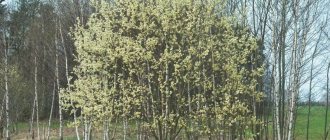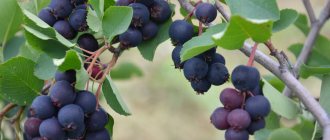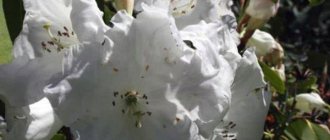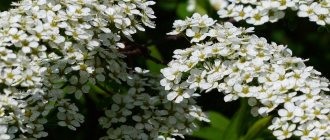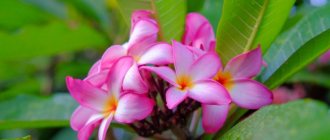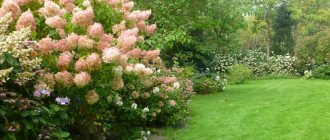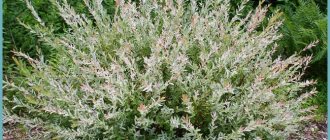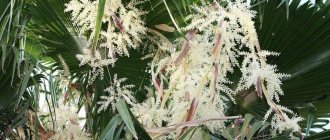In the Japanese garden there is always a place for an evergreen, elegant, upright shrub - pieris. It belongs to the heather family. Its homeland is Japan and the Kuril Islands. The flowers form dense clusters and have a persistent sweetish aroma. Its height reaches 200-250 cm, and it belongs to the slowly growing garden plantings. Depending on the variety, they are soft pink or snow-white. The flowering period is long: from April to June.
- Seeds
- Selecting a landing site, requirements and soil preparation
This is an indispensable element of landscape design. The bright young, drooping shoots of this tall garden planting can transform any corner of the garden. Evergreen, lanceolate leaves play beautifully in the sun. The exotic, attractive appearance does not require special, complex care. As a fruit in the fall, the plant produces a brown seed capsule. The root system is superficial. Many varieties are poisonous. The shrub tolerates low temperatures well, which is why it is actively used for decorative purposes in central Russia. With proper care it can live for many years.
Poetic name
The name of the genus is given in honor of the ancient Greek muses of the Pierides, who, according to legend, lived in one of the regions of Macedonia. They received their inspiration by contemplating and consuming water from the Piera spring.
In our latitudes, the name podbel is common - the edges of the variegated leaves seem to be whitened.
The species' range covers the territories of Taiwan, Japan, and Eastern China. Most often, these shrubs are found on mountain slopes, well illuminated by sunlight, as well as in bush thickets and forests.
The original Japanese Pieris bushes are a real treat for the eyes. The unusual appearance of the plant will give the site an exotic feel. Having seen the brightest pieris bushes, you will undoubtedly want to place it in your garden or home. Most often, pieris is cultivated in open ground, but it adapts perfectly to indoor conditions. Growing and caring for any option is not particularly difficult.
Types and varieties of Pieris
The genus Pieris of the Heather family includes 7 species of evergreen low shrubs or small trees, as well as liana-like plants with creeping woody pagons, rushing upward along the trunks of neighboring trees.
Several of them are known in cultural cultivation:
- Jermyns - this variety is suitable only for growing in regions with warm winters: all the cold months of the year the plant is decorated with bright red buds.
When does pieris bloom?
How pieris blooms In the photo, the variety Pieris Japonica Red Mill
The flowering period of Japanese Pieris occurs in March-April; in the conditions of central Russia, flowering starts in mid-summer. The flowers are snow-white, shaped like bells with a diameter of about 1.5 cm. Paniculate inflorescences 5-12 cm long hang gracefully. Varieties may have red or pink flowers.
Varieties of Pieris japonica
Breeders have bred quite a lot of varieties; we focus your attention on the most popular and decorative ones. Most of them have young leaves that are copper-red in color.
- Mountain Fire (photo above) is one of the most famous varieties, a compact bush - up to 1.5 m in height, dense structure, grows slowly. Young leaves have a color from red-bronze to light brown, dark red.
- Debutane is a dwarf variety that does not grow more than 1 m.
- Pieris japonica Flaming Silver (in the sixth photo) is a variety of controversial selection, which in some literary sources is classified as Pieris beautiful. A characteristic feature is the presence of a silver-white border stripe on the leaves.
- Valley Valentine is a shrub with pink young shoots, large bell-shaped flowers of a rich red hue.
- Red Mill is a shrub up to 2 m high. Young leaves are painted red, later they turn green, dense and shiny, collected in a whorl. The flowers are white, bell-shaped.
- Variegata (in the third photo) is a medium-sized shrub (1.8-2 m), green leaves with a silver stripe along the edge. Young shoots are pink.
- Scarlet O'Hara is the fastest growing cultivar among all the others.
Choosing a site for planting
Illumination
Planting in shaded areas is preferable; direct sunlight in the afternoon is acceptable. Variegated forms will require more intense lighting to maintain leaf color. The place should be secluded - without drafts or strong gusts of wind, otherwise the pieris may shed its unopened buds. High air humidity helps for more active growth and lush flowering.
Priming
Given the fact of symbiosis with fungi, the soil requires an acidic reaction. It should also be loose, crumbly, and allow air and water to pass through perfectly. Specialized stores sell acidified soil - add it to the planting hole or use it when growing in a pot. The following mixture is also suitable as soil: 2 parts peat, 1 part river sand, 1 part leaf soil, also add sawdust. In addition, when digging the site, you should add 200 g of complex mineral fertilizer and 35 g of sulfur (proportions per 1 m²).
Lighting and location
In order for the plant to grow well, it should be provided with partial shade; the sun should shine on it only in the afternoon. Many varieties of shrubs need sun; without it, the leaves will not have such interesting colors, but will take on the usual green color. The plant also does not like cold northern winds and drafts; they force the plant to part with its flowers and leaves much faster. If the humidity in the air is high, this will only benefit the bush.
The soil for shrubs is required with high acidity, which has good moisture and air permeability. Such soil can be found in any specialized store, or you can make it yourself. The composition is made from acidic peat, river sand, to which mineral fertilizers and sulfur are added.
Growing pieris from seeds
Pieris seeds photo
Growing from seeds involves the seedling method - seedlings 2-3 years old are transplanted into open ground. If you buy seedlings from a nursery, inspect them carefully; the leaves should not be yellowed or curled.
- Take wide containers with acidic soil (two parts each of coniferous soil and peat with the addition of one part sand).
- Level the surface of the soil, distribute the seeds without burying them, but only lightly pressing them into the ground with your finger.
- Complete the procedure by spraying with a fine spray.
- Cover the crops with glass or film to ensure high humidity conditions, but lift the cover daily to get rid of condensation.
- Germinate the seeds at an air temperature between 22-25 °C, the lighting should be bright but diffused.
- Shoots will appear after 1 month.
- After this, the cover should be removed.
- When the seedlings develop 3-4 true leaves, the sprouts are planted in separate containers.
- It would not be superfluous to treat with a fungicide, which is the prevention of blackleg damage.
- In spring and summer, take containers with sprouts out into the garden.
Propagation of Pieris japonica by cuttings
How to take pieris cuttings
Autumn is the best time to harvest pieris cuttings. Cut the apical cuttings 6-10 cm long, make the cut at an acute angle, then treat it with charcoal crumbs or a growth stimulator.
Pieris cuttings
- For rooting, plant the cuttings in individual containers with a sand-peat mixture, cover the top with a glass jar or a cut plastic bottle or a plastic bag.
How to propagate Pieris from cuttings
- Keep the soil surface moist, raise the cover for ventilation, and when the cuttings “take root”, it can be removed.
- In the spring, when the threat of return frosts has passed, young plants can be transplanted into open ground.
Planting and propagation of shrubs
Landing
Shrubs are planted in the same way as all plants, but there are some nuances. The hole should be dug up to twenty centimeters deep, due to the superficial root system. Before planting, the root system should be immersed in water for a while to soak it. And only after that they are planted.
Reproduction
To get good offspring, you can propagate pieris both by seeds and cuttings.
Seeds
In acidic soil, grooves are made with a pencil into which the seeds are poured. Then they cover it with glass so that the plants are safe from direct sunlight, but at the same time the humidity is high. The air temperature should be from twenty-two degrees to twenty-five degrees. There is often no need to water the seeds, only when the soil begins to dry out. The plant begins to sprout approximately one month after planting.
Reference. When the first leaves appear on the young shoots, they should be picked into separate containers. To prevent the plant from getting sick, it should be sprayed with a special fungicide solution.
You can start hardening off seedlings already in the spring; to do this, they should be taken out into the air for a couple of hours. After two to three years, young seedlings can be planted in open ground.
Cuttings
It is best to harvest cuttings in the fall. They are done like this: you should step back up to ten centimeters from the top of the shoot and cut it at an acute angle, then you should treat it with coal dust. Then the cuttings are planted in containers with a mixture of peat and river sand, watered infrequently, only when the soil begins to dry out. Seedlings are planted in open ground in the autumn, when there should be no more frosts.
Plant care
The soil under the plant should always remain moist. Water the shrub at an early age with three liters up to three times a week, but for an adult shrub one bucket of water is required up to three times a week. During the growing season, you can water more often, but when there is intense heat and there is no rain, the shrub still needs to be sprayed periodically.
If you have recently planted a plant or transplanted it, then you can fertilize it only after two months. The bush is fed twice a month with diluted organic fertilizers.
Planting pieris in open ground
How to plant Pieris japonica
It is best to plant Pieris seedlings in open ground in the spring. The root system is superficial, so planting holes are made 15-25 cm deep and about 35 cm wide. Carefully remove the seedling from the container and, together with the earthen ball, hold it in warm water so that the roots are thoroughly wet. Then place the plant in the center of the hole and cover it with soil. The root collar should be deepened into the soil no more than a couple of centimeters. Build a soil roller around the planting hole and water the seedlings well. After the soil surface has dried, the roller can be leveled.
Please note that loosening the soil is not recommended - this can damage mycorrhiza. Therefore, it is advisable to mulch the tree trunk circle immediately after planting with pine bark, sawdust or peat. This will help keep the soil moist, prevent crusting on the surface and inhibit the growth of weeds.
Caring for Japanese Pieris in the garden
How to water
Overmoistening of the soil or lack of moisture is equally dangerous for Pieris. Maintain regular and balanced watering. If there is no precipitation, water the pieris 2-3 times a week. For each young plant, spend 4 liters of water, for an adult you will need 10 liters. Even with normal watering, in particularly hot weather, the leaves of Pieris may droop - additionally spray the plant in the morning and evening hours.
How to feed
Newly planted pieris will take about two months to take root properly. After this period, you should begin to apply fertilizers at intervals of 2 weeks. Use liquid organic matter as fertilizer. Please note that it cannot be applied fresh, since the increased nitrogen content can destroy the root system. So, mullein or chicken droppings are diluted with water in a ratio of 1 to 10.
Trimming
There is no need for special bush formation. Sanitary pruning is carried out periodically, removing dried shoots. In early spring, shoots can be pruned to encourage tillering.
Pieris winter hardiness and preparation for winter
Many people are interested in the question of whether pieris can withstand the cold winters of the Moscow region. Fortunately, the heat-loving eastern guest is quite hardy. Japanese Pieris winters well in open ground, as it can withstand temperatures as low as -30 °C. However, to prevent the root system from freezing, mulch the soil surface with peat and cover the bush with non-woven material (the cover is attached to the frame).
How to replant Pieris japonica
When grown in open ground, the plant will not need to be replanted.
Pieris japonica growing in a pot should be replanted once every 2-3 years. Increase the size of the container slightly. To ensure everything goes painlessly, you cannot expose the rhizome; roll it along with the earthen lump.
When working with pieris, keep in mind that the plant is poisonous. The toxicity is caused by the high content of the glycoside andromedotoxin. Signs of poisoning: decreased blood pressure, dizziness, diarrhea, vomiting; with a particularly high dose - breathing problems.
Reproduction
Reproduction is carried out in two main ways:
- Cuttings.
- Growing from seeds.
Seeds are sown in special containers under film and grown at home. After the emergence of shoots, picking is carried out. And seedlings are planted in open ground only after 2–3 years, when they have become stronger.
Pieris seeds
As for propagation by cuttings, this is a simpler method. Cuttings are cut from the tips of the shoots. They do this in the autumn. Cuttings are planted in prepared pots and also grown at home. Seedlings are planted only in the spring, after the last frost. The roots and soil should be placed in a container of water and kept in it for a while. After this, the seedling is planted in a hole, covered with earth, watered and mulched with bark.
Diseases and pests
The plant is extremely resistant to diseases and pests.
Under unfavorable care conditions, various fungal diseases or chlorosis may occur. In the first case, twice-daily treatment (1 week interval) with a fungicidal preparation will help. To save from chlorosis, you will need to add iron chelate.
Most often, pieris can suffer from an attack by spider mites. Sticky whitish cobwebs can be found on the stems and leaves. The pest can be controlled by treating with insecticides.
Pieris in landscape design
Pieris in landscape design photo
Japanese Pieris looks great both in solo and group plantings. Thanks to its elegant and compact growth form, it will become a noticeable accent of a mixborder, a wonderful decoration of a green lawn, the entrance to a house, a recreation area or a personal plot.
Pieris Japanese variety Little Heath Pieris japonica 'Little Heath' photo
Colorful leaves and exquisite inflorescences will add exoticism and will fit favorably into any design (Moorish, Muslim, Japanese gardens, etc.). The enchanting aroma of flowering will create a romantic and relaxing atmosphere.
Pieris japonica in landscape design photo
Bright pieris is planted in rock gardens, rockeries, flower beds, and used in border plantings. The darkest and most inconspicuous areas of the garden can be “lit up” with the help of this plant.
Pieris is unpretentious and gets along well with many neighbors. The most harmonious combination with azaleas and hydrangeas. Often combined with trillium and heather. And in the lower tier of the multi-level composition, the party will consist of Kashmiri corydalis, bright red Erica and common sorrel.
What does a pieris plant look like?
Most evergreen shrubs grow neat and compact, reaching a height of 50 cm to 6 m.
Like many heathers, pieris create a symbiosis with fungi and therefore live only in acidic soil.
The leaf blades of Pieris are oval and elongated, pointed at the tip and jagged at the edges.
Their surface is smooth and shiny. Each leaf reaches from 2 to 10 cm in length, depending on the type and variety.
On the shoots, the leaves are arranged in a spiral or in bunches at the tops of the branches. Young growths are pink, crimson or completely white, then turn green.
The corollas are bell-shaped, similar to lily of the valley, white, pink or red-raspberry in color, measuring from 0.5 to one and a half centimeters, collected in erect or drooping paniculate inflorescences up to 12 cm long.
The fruits are woody, five-leaf capsules of an oval-flattened shape.
All parts of the plant contain a toxic substance - the glycoside andromedotoxin.
Penetrating inside the human body, it causes a drop in blood pressure, difficulty breathing, vomiting, diarrhea, and dizziness.
Growing pieris at home
Low-growing varieties of Japanese Pieris should be grown indoors.
Basics of growing Pieris indoors:
- Provide good lighting. If there is a shortage of it, the variegated properties of the plant will be lost, so place the plant on windows facing east or west. When located on the south side, provide protection from direct sunlight.
- When grown indoors, more frequent watering will be required, since the limited space and location of the rhizome near the soil surface causes rapid absorption of moisture.
- The structural features of the root system (although it is superficial, it branches very well) make it necessary to choose a wide container.
- From spring to autumn, feed every 2 weeks with complex mineral fertilizers.
Plant appearance
An adult plant grows in height from one meter to six meters, but three-meter shrubs are most often found. These plants grow on slopes in the mountains, in direct sunlight, in forests and bushes. Pieris has oval leaves with a sharp end, about ten centimeters long and four centimeters wide. The leaves are colored in shades ranging from white to red.
The buds on this shrub appear only at the end of autumn, and delight the eye until spring. Pieris flowers look like small bells, which are only about one and a half centimeters in size. All flowers are collected in inflorescences, the size of which varies from five centimeters to twelve centimeters. Most often you can find white flowers, but there are shrubs with pink and red flowers.
